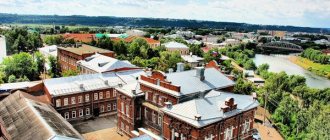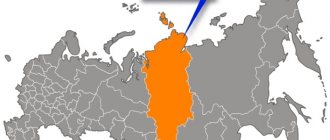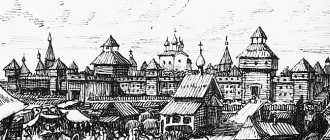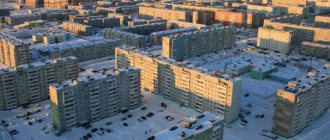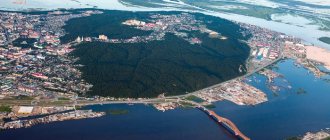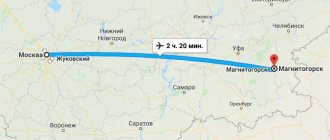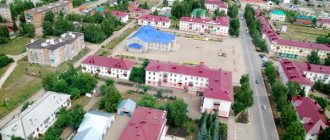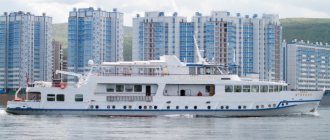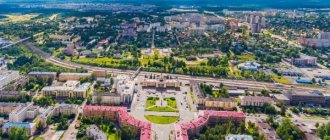Far in the far north of Russia, where a harsh, frosty climate prevails, there is an amazing region called Priobye. This part of the Khanty-Mansiysk Autonomous Okrug is located 250 km from the administrative center of the Tyumen region.
One of the youngest cities of the Ob region is Pyt-Yakh. A region with an area of about 6,500 hectares and a population of approximately 40 thousand people. The small oil region is located on the right side of the Bolshoy Balyk River, which flows throughout the Nefteyugansk and Surgut regions and flows into the Yuganskaya Ob channel.
Where the city of Pyt-Yakh is located can be seen on the geographical map of Russia - this is the place of wells where black gold is methodically extracted. The underground depths are being emptied at every step, right in the city. And not in vain, the symbolism of the region is made in the form of a coat of arms with the image of a bird of the Siberian taiga - a capercaillie, which holds in its paws a silver-black disk, symbolizing an oil source.
City information:
- Founded: 1968
- Population: 40,798 people. (for 2022)
- Telephone code: +7 3463
- Area: 80.4 km²
Today, Pyt Yakh is a rather promising region with developed infrastructure, good highways, and huge industrial enterprises for the extraction and processing of oil and oil and gas products, which are part of the largest industrial companies in Russia.
Pyt-Yakh is a young city, but already has its own attractions
Competitive forestry enterprises in Pyt Yakh supply environmentally friendly wood throughout the country. Thanks to its favorable geographical location, the young city continues to develop and increase its production turnover.
Pyt Yakh on the map of Russian transport infrastructure is considered an important railway junction of regional importance, which provides connections with other autonomous okrugs of the region. Here in the mid-70s a railway was built from Tyumen to Surgut and further to the north. A station was created along this route, which received the ancient Khanty name of the local river Pyt-Yakh.
In addition, in the far northern region, just 90 km from the city center, there is the largest airport in Surgut, providing international and local flights. More distant from the center of Pyt-Yakh, at a distance of 175.4 km, Pokur Airport also plays a significant role in the transportation of goods and passengers for local and long-distance traffic.
A fairly young city was formed and became famous thanks to one of the largest deposits of oil reserves in the West Siberian province of Russia, called the Mamontovskoye field. The history of development dates back to the beginning of 1960, when oil reserves were first discovered in these places.
Etymology
Pyt-Yakh is a Khanty word in the Surgut (Yugan) dialect.
Yah - people, community, community, settlement. Compare: ramid-yakh
(“people of the big channel”) - the Khanty name for the Sockeye salmon;
Okhsar-yakh
(“fox people”) - the Khanty name of the pando genus;
in revolutionary times, the Khanty called the “reds” and “whites” nothing more than vyrd-yakh
(“red people”) and
nayvi-yakh
(“white people”);
the outdated name of the Khanty is “ as-yakh
” (“Ob people”), and their self-name is
kantykh-yakh
.
The word "Yah" can also mean "river". In the Nenets language, “river” sounds like “yakha” (the rivers of Yamal: Mordy-yakha, Yassovey-yakha, Yanzor-yakha
and so on.).
Ramid-yakh
most likely means “big river”, and
Okhsar-yakh
means Fox River.
Khanty clans could be named after the rivers on which they were settled. By the way, the city of Pyt-yakh is named after the river Pyt-yakh
, which flows into the
Bolshoy Balyk
.
Nearby there are the rivers Kut-yakh
and
Sivys-yakh
, on the banks of which there are settlements of the same name. It is quite logical that in the compound names of rivers, the part “yakh” means “river” (similar to the Nenets “yakha”), and not “people, community, settlement.” Usually rivers give names to settlements, and not vice versa.
The word “Pyt” has an ambiguous meaning among the peoples who lived closer to the area: 1) according to the etymological dictionary of I. P. Frolov, “pyt” means “path”; 2) the Khanty meaning of the word “pyt” is “lair”.
From the above word-forming parts, an expedient meaning is derived, in which “Pyt-Yakh” is revealed as a “river path”.
Population
Population as of 01/01/2010
| № | population composition | number of inhabitants (persons) |
| 1 | preschool age (up to seven years) | |
| 2 | schoolchildren (from seven to seventeen years old) | |
| 4 | middle age (from thirty years to retirement age) | |
| 3 | youth (up to thirty years old) | |
| 6 | Total population: | 41 586 |
| 5 | retirement age |
Story
At the beginning of the 20th century, on the right side of the Bolshoy Balyk River, not far from the Pytyakh River, there were yurts of the Ochimkins. They were engaged in squirrel fishing on both banks of the Bolshoi Balyk. In the spring, “fish are hunted in Dolmatkino Pol... In winter, fish are hunted along the Pyt-Yakh River with kots and up to 6 pounds of pike are caught.” By the way, researchers include the Khanty prince Tonya in the Ochimkin family, who is considered a mythical figure and is mentioned in traditions and legends.
The Mamontovskoye oil field was discovered in 1968, and its development began in 1970. This field was considered the second after Samotlor in terms of oil reserves in Western Siberia.
In 1970, the village was a chaotic accumulation of beams and trailers with numerous wooden walkways and bridges across the swamps surrounding Mamontovo. But even under these conditions, oil workers from Tyumen, Kuibyshev, Kazan and Ufa lived and produced oil.
On March 2, 1980, the construction of the villages of Mamontovo and Pyt-Yakh was headed by the oil and gas production enterprise NGDU Mamontovneft, led by the legendary oilman Boris Isaevich Nuriev. The construction itself was headed by the deputy. chief of capital construction of NGDU "Mamontovneft" Oleg Aleksandrovich Vashkevich, who managed to provide the city with both labor and building materials in the conditions of the north and the Soviet system. A large landing of builders arrived from Magnitogorsk. It was Magnitka that formed the backbone of the SU-79, which carried out construction work. In total, about 10 thousand people arrived. The head of Yuganskneftegaz PA, Roman Ivanovich Kuzovatkin, provided considerable assistance.
In March 1982, the villages of Mamontovo, Pyt-Yakh and Yuzhny Balyk were united into one urban-type settlement - Pyt-Yakh.
In 1983, the first library opened in the village of Pyt-Yakh - a branch of the Nefteyugansk centralized library system. The first librarian is Olga Aleksandrovna Grishina.
On August 6, 1990, the village of Pyt-Yakh, Nefteyugansk region, was given the status of a city of district subordination.
Sights of the city of Pyt-Yakh
Pyt-Yakh exists on the map of Russia as an oil city. The history of its development is not very long, but over the years of its existence, its own attractions and cultural objects have appeared here.
This:
The open-air park - historical and ethnographic museum was created by city residents in 2001. On their initiative, the museum was organized in the southern region of the region on a natural, picturesque landscape in the form of an architectural complex of the property of the Yugan Khanty.
The museum object is designed as a summer estate with a small house, two utility rooms and sheds. The house has an oven for baking bread, which was made by local resident A.A. Kakov. On holidays and excursion days, museum workers bake delicious pies and bread in it, which they treat all guests of the estate.
In the farthest corner of the park area there is a sacred place where a mighty cedar grows surrounded by young birch trees. According to local beliefs, the tree has a sacred meaning and served as an invisible connection with the gods of our ancestors.
Today, indigenous residents and guests of the city bring multi-colored ribbons with wishes and decorate the tree.
The local history museum is located in the local library building. There are several halls here, the first holds thematic exhibitions, the second exhibition hall demonstrates the culture of the Khanty peoples and the stages of development of the northern region. The collection of museum exhibits includes about 4,000 historical and cultural values of Ugra.
The Ayaun settlement is recognized as one of the archaeological monuments . It is located in the south-west direction on the left bank of the Bolshoy Balyk River, at a distance of 10 km from Pyt-Yakh. The attraction is a hill with an area of 24 square meters. m. with an elliptical shape and two depressions, around which, judging by the remains, there was a deep ditch with water.
Excavations here have been taking place since 1982, during which two above-ground parts of rectangular dwellings with hearths in the center, household items, dishes with patterns, grinding stones, clay pots and ceramics were discovered. The monument is interpreted as a seasonal, temporary settlement of northern generations.
Memorial complex "Monument of Glory" in honor of the fallen soldiers in the Second World War in the city center. The monument is made in the form of an arrow rising high and an eternal flame. The names of fallen soldiers are engraved on the arrow.
A techno-monument in the form of an authentic combat vehicle with rocket artillery, it was installed in memory and glory of the defenders of the fatherland.
Not far from the station there is a unique creation - a dwelling of the descendants of northern peoples called a chum. They were built carefully and to last for many years. The basis of such a dwelling is poles, and their number depends on the size of the tent. Usually, the poles are installed at the same distance from each other, wrapped with ropes using special technologies, and covered with reindeer skins on top.
The center of such a dwelling was determined where the hearth was supposed to be. According to archaeologists, such huts were familiar to the most ancient hunters of Siberia. Today, a reminder of the life of our ancestors, performed in a more modern interpretation, can be observed in Pyt-Yakh.
There is also the Orthodox Cathedral “Unexpected Joy”, which is located among the forests and is considered one of the most beautiful places in the city.
Economy
The following activities operate in the city:
- Oil producing enterprise - LLC RN-Yuganskneftegaz;
- “Yuzhno-Balyksky Gas Processing Plant” is a branch of JSC SiburTyumenGaz, the main activity is the processing of associated petroleum gas from oil fields of LLC Rosneft-Yuganskneftegaz;
- LLC "Borets Service - Nefteyugansk", the main activity of the enterprise is the provision of other services related to oil and gas production;
- Timber industry company Pyt-Yakhsky branch of OJSC RLC KodaSalymLes;
- Pyt-Yakh branch of the Nefteyugansk branch of RN-Inform LLC;
- Pyt-Yakhsky branch of RN-Avtomatika LLC;
- RITS-1 LLC Mamontovsky KRS;
- Federal chain stores: “Magnit”, “Pyaterochka”, “Monetka”, “Krasnoe Beloe”, “Ermolino Products”, “Svetofor”, digital and household appliance stores “DNS” and “RBT.ru”, communication stores “Euroset” , “Svyaznoy”, “Megafon”, “Tele2”; “Kari”, “Galamart”, “Magnit Cosmetic”, “Sela” and others.
The average salary at the end of 2022 was 66,335 rubles.
Today the city has everything necessary for life: an equestrian club, comfortable housing, a hospital, clinics, cultural centers, shops, schools, kindergartens, gyms, a children's art school, a creativity center, a children's rehabilitation center, a cultural center for the peoples of the North, a branch Nefteyugansk Industrial College, five branches of the central library system. In 2010, the Pyt-Yakh district hospital was opened with the first modern burn center in the Khanty-Mansi Autonomous Okrug.
Transport system
Railway transport
In 1988, a modern building of the railway station of the Sverdlovsk Railway was built. Pyt-Yakhsky railway station is the nearest railway station for residents of Nefteyugansk.
Urban transport
The organization of passenger transportation by public transport is carried out by 1 carrier - a municipal unitary passenger motor transport enterprise, the number of bus routes in city traffic is 40 units, including 6 special routes, the daily output of buses is more than 18 units. The fare is 26 rubles. List of routes:
- 1 “Railway station - Mamontovo (10 microdistrict)”;
- 2 “Railway station - Cheryomushki (9th microdistrict)”;
- 3 “Railway Station - District Hospital”;
- 4 “Railway station - GPZ (7th microdistrict)”;
- 5 “GPP (7th microdistrict) - Mamontovo (10th microdistrict)”;
- 6 "Mamontovo - Railway Station - 2a microdistrict";
- 10 “Railway station - SK Zhemchuzhina - Mamontovo (10th microdistrict)”;
- 18 In the morning and evening: “Atlant - Railway Station - Daci (Puchip)”, In the afternoon: “Railway Station - Atlant - Daci (Gidrovets)”. The bus is open for the summer
Ski recreation center "Northern Lights"
The base is located in microdistrict 5, you can get here from the train station by bus. The address of the ski resort in Pyt-Yakh can be viewed on the interactive map of Russia: Solnechnaya st., 13. “Northern Lights” is open to its guests all year round. The base offers walks through winter forests, snowboarding, alpine skiing and even figure skating lessons.
For the youngest visitors, for winter recreation there is the opportunity to ride down the hills on snow scooters.
In the summer, mountain excursions and rental of gazebos and barbecues for picnics are popular. The ski resort has a large area for roller skaters and skateboarders from all over the area. In addition, there is a specialized tennis court at the base.
In winter, it turns into a huge open-air glacier castle for ice skaters. Not far from the base, there is a natural reservoir , which in winter is an amazing sight - a frozen lake against the backdrop of tall and dense spruce trees.
In summer, there are water attractions with electric boats for children and parents.
The Northern Lights ski recreation center offers rental of a variety of sports equipment for recreation at any time of the season. The base is open in the winter from 12:00 to 19:00, weekends from Monday to Wednesday. During the summer season, opening hours are from 08:00 to 17:00 from Monday to Wednesday, and from 10:00 to 19:00 from Thursday to Sunday.
Pyt-Yakh is not rich in entertainment and fashionable leisure. But those who want to take a break from the bustle of the city and information excess, to be alone with themselves, should go to the northern region on the map of Russia, which will greet you with the power of its forests, seething rivers, silent lakes, unsteady sun and stars.
Article design: E. Chaikina
Culture
The city has 6 secondary schools, 10 kindergartens, and a children's and youth sports school.
There is a television and radio company and a regional newspaper in the city.
The history of music education in Pyt-Yakh begins in 1987, when a children's music school was founded. In 1996, the music school was reorganized and became part of the Children's Art School as a music department. In 2010, the school population was 1,100 students, 110 employees, of which 67 were teachers.
Climate and weather in the city
Pyt-Yakh on the map of Russia, meteorological diagrams and weather conditions, is listed as one of the regions of the Far North, where a continental climate prevails. It is characterized by stable frosty winters, little precipitation and not too warm summer months.
The winter months here last from November to March, the lowest temperature occurs in December and January and in some places it can drop to 26 ° C, and piercing winds bring additional discomfort on cold days.
A slight warming begins at the end of April, and in the summer, in particular in June and July, the maximum heat does not exceed 18 °C. At the same time, there are often cold days with slight frosts at night. Summer in Pyt-Yakh is short and quite cool.
Changes in average monthly temperature throughout the year:
| January | February | March | April | May | June | July | August | September | October | November | December | |
| Average monthly temperature | -21 | -20 | -11,5 | -2,3 | 5,7 | 13,9 | 17,9 | 14 | 8,3 | -1,4 | -12,2 | -17,9 |
| Mini-small | -25,5 | -24,8 | -17,1 | -7,2 | 0,8 | 9 | 13,2 | 9,8 | 4,5 | -4,3 | -16 | -22 |
| Maximum | -16,7 | -15,2 | -5,9 | 2,6 | 10,7 | 18,9 | 22,6 | 18,3 | 12,1 | 1,5 | -8,3 | -13,5 |
The maximum amount of precipitation will fall in the summer, reaching 80 mm. In the dry, frosty season, their average monthly value does not exceed 30 mm. This is the territory of the Arctic zone, forest-tundra and northern taiga tundra, with harsh climatic features.

